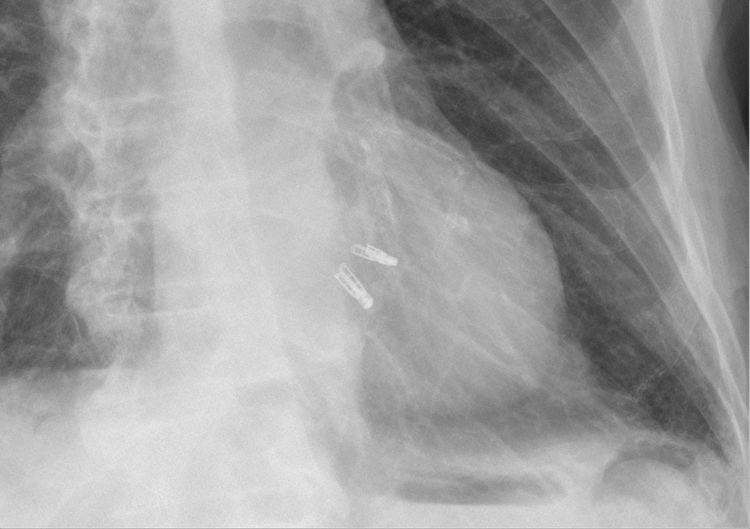 | ||
MitraClip (mitral clip) is a novel, percutaneous method of heart treatment that is targeted for patients who have been denied surgery to fix mitral valve regurgitation. MitraClip was first implanted in 2003, and in 2013 became the FDA's first commercially approved alternative to mitral valve regurgitation surgery. Open-heart surgery is the standard method of treatment for patients with mitral valve regurgitation, however it is very invasive and not a feasible option for all patients. The risk of complications and mortality greatly increase in patients with other health conditions like liver disease, previous chest surgeries, and age above 75, which is why they are often denied surgery. The implantation of MitraClip via catheter does not involve open-heart surgery, but mimics the surgical method of edge-to-edge valve repair. The mitral valve leaflets are clipped together with the device instead of being sutured together, making this procedure much less invasive but still effective for improving the heart's blood outflow.
Contents
Since 2013, MitraClips have been implanted as a new strategy to correct the motion of the mitral valve in selected patients with severe obstructive hypertrophic cardiomyopathy (HCM). The mitral clip has not yet established the long-term reliability of septal myectomy or alcohol septal ablation, but HCM specialists are increasingly offering the clip as a less-invasive treatment option.
The MitraClip is made of chromium and cobalt and is covered in polyester to promote the growth of tissue around the clip. It was developed by Evalve Inc., which became a division of Abbott Laboratories.
Procedure
Patients are placed under a general anesthetic, and a catheter containing the MitraClip is inserted into the femoral vein. Fluoroscopy (X-ray imaging) helps the surgeon to guide the device through the venous system to the heart. Once at the heart, echocardiography (ultrasound imaging) is used to position the device at the mitral valve. The device enters the heart through the inferior vena cava to the right atrium. The surgeon will pass the catheter through the septal wall between the two atria, allowing the device to pass to the left atrium. This is a very precise puncture that requires both the echocardiography and fluoroscopy images to locate the proper area. The MitraClip passes through the annulus into the left ventricle and sits below the leaflets. Once on the ventricular side of the mitral valve, the MitraClip is opened and pulled towards the atria. The open MitraClip grabs both mitral valve leaflets, the surgeon closes the clip, and the leaflets are clipped together. Fastening the clip to the leaflets decreases regurgitant blood.
The use of both echocardiography and fluoroscopy is necessary to perform the implantation of MitraClip. However, this requires the surgeon to mentally fuse the images from these two separate methods. The use of new technology called the EchoNavigator software can merge the images from echocardiography and fluoroscopy. This software aims to reduce procedure time and increase success in MitraClip procedures. The integration of both imaging techniques is especially valuable during the puncture of the atrial septum and while grasping the leaflets and fastening the MitraClip. These are the two steps that are dependent on the surgeon having precise placement in the heart, and the EchoNavigator helps with this placement. In cases where multiple MitraClips are necessary to decrease the mitral regurgitation, the use of EchoNavigator can substantially reduce the procedure time.
Abbott expanded its MitraClip training process in 2016, after several instances of surgical complications.
Indications and effectiveness
MitraClip benefits many patients who were initially denied surgery. It is successful at reducing mitral valve regurgitation, improving physical health, vitality, emotional health, and decreases recovery time compared to open-heart surgery. The quality of life is significantly improved in patients who undergo the MitraClip procedure compared to those who did not and are living with mitral valve regurgitation. Open-heart surgery remains the preferred treatment option when possible, due to the effectiveness and long-term record of the procedure in reducing mitral valve regurgitation. The MitraClip provides an alternative to the surgical procedure and is benefitting many patients for whom in the past, mitral valve regurgitation was a detrimental condition they were forced to live with.
